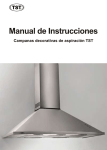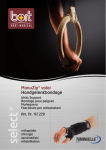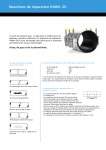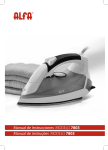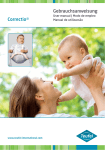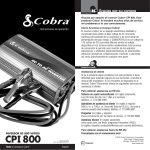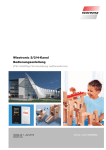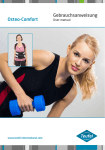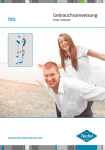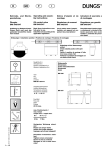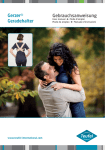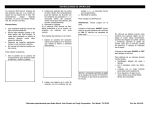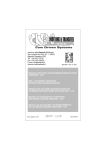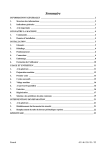Download Gebrauchsanweisung EFO Hüftgelenk
Transcript
EFO Hüftgelenk-Bandage Gebrauchsanweisung User manual | Mode d‘emploi Modo de empleo | Manuale d´instruzioni www.teufel-international.com EN D EFO Gebrauchsanweisung Inhalt 2Beschreibung 2Indikation 2Kontraindikation 2Funktion 3Maße/Größen 3Anwendung 4 Wichtige Hinweise 5Material 5Produktpflege/Reinigung/Wartung 5Lagerung/Entsorgung Beschreibung Die EFO ist eine Bandage zur elastisch führenden Stabilisierung des Hüftgelenks. Das Bein wird in seiner Bewegung geführt und gelenkschädigende Beinstellungen werden durch einen spürbaren Widerstand angemahnt, so dass der Patient diese vermeiden kann. Der Stabilisierungsgrad kann durch den stufenlos einstellbaren zirkulär ausgeführten Verschluss und die seitlichen Spiralfedern individuell definiert werden. Die EFO ist in 4 Größen, jeweils für links, rechts und doppelseitig lieferbar. • • • • Elastisch führende Bewegungsbegleitung Stufenlos einstellbare Stabilisierung Auch unter Kleidung unauffällig zu tragen Einfache Handhabung Indikation • Reizzustände bei Arthrose/Arthritis •Postoperativ Kontraindikation • Fehlende Patienten-Compliance Funktion 2 • Stabilisierung der Hüfte durch gleich mäßige, zirkuläre Kompression der Weichteile EN EFO Gebrauchsanweisung D Maße/Größen EFO REF einseitig links REF einseitig rechts REF doppelseitig 40 367 101 40 367 201 40 367 301 1 48 60-80 40-55 40 367 102 40 367 202 40 367 302 2 48 70-100 50-65 40 367 103 40 367 203 40 367 303 3 48 90-110 55-70 40 367 104 40 367 204 40 367 304 4 48 100-130 60-75 Größe Höhe/cm HüftOberschenkelUmfang/cm Umfang/cm Anwendung Notwendige Maße: Hüft-Umfang/cm (Umfang 1) Oberschenkel-Umfang/cm (Umfang 2) Umfang 1 Umfang 2 1. 2. 3. 4. Die Bandage muss faltenfrei und ohne Kantendruck am Körper anliegen. Die seitliche Druckplatte mit Spiralfedern muss dabei seitlich über dem Hüftgelenk sitzen. Die Kompression ist so zu wählen, dass eine gute stabilisierende Wirkung auf das Hüftgelenk erzielt wird, ohne den Patienten zu stark einzuengen. In seltenen Fällen ist eine individuelle Anpassung an den Patienten notwendig. Die gewünschte Stabilisierung kann durch das eventuelle Herausnehmen von einzelnen Spiralfedern reguliert werden. Bei Patienten mit überwiegend sitzender Tätigkeit kann unter Umständen auf die vordere Spiralfeder verzichtet werden. 3 EN D EFO Gebrauchsanweisung Wichtige Hinweise 4 • Vor der Benutzung ist eine individuelle Anpassung der Orthese und eine Einweisung in den Gebrauch durch einen erfahrenen Orthopädietechniker entsprechend der ärztlichen Anwei sung erforderlich. • Falsche Auswahl, Anpassung, Anwen dung und/oder mangelhafte Kontrolle der Passform des Produktes können zu gesundheitlichen Schäden führen. • Die Orthese nie auf verletzter Haut tragen. • Die Orthese vor jedem Anlegen auf Beschädigungen überprüfen (z.B. lockere Verbindungen, Verschlüsse, Gurte, etc.). • Bei vermuteten Leistungsstörungen (z.B. dem Gefühl einer nachlassenden oder unzureichenden Wirkung) muss unverzüglich der Arzt oder Orthopä dietechniker aufgesucht werden. • Die Orthese muss regelmäßig von einem Arzt oder Orthopädietechniker auf ihre Funktion, korrekten Sitz und eventuelle Beschädigungen überprüft werden. Die Abstände der Kontrollen sind für jeden Patienten individuell festzulegen. • Sollte das Produkt einer unverhältnis mäßig starken Belastung ausgesetzt gewesen sein, muss es vor der weite ren Verwendung von einem Orthopä dietechniker auf mögliche Schäden überprüft werden. • Scharfkantige Ränder u.ä., die durch spanabhebende Bearbeitung des Pro duktes auftreten können, müssen zur • • Vermeidung von Hautverletzungen entgratet werden. Unzuträglicher Druck durch die Orthese kann zu Hautschädigungen und Durchblutungsstörungen führen und muss daher vermieden werden. Die Orthese ist durch die notwendige individuelle Anpassung (produktabhängige Formung und/oder spanabhebende Bearbeitung) nicht zur Wiederverwendung bei weiteren Personen geeignet! EN EFO Gebrauchsanweisung Material Lagerung/Entsorgung •Baumwolle •Elastan •Viscose •Polyamid •Latexschaum Das Produkt enthält keine umweltgefährdenden Stoffe. Es kann über den Hausmüll entsorgt werden. Produktpflege/ Reinigung/ Wartung • Klettverschlüsse vor dem Waschen schließen •Handwäsche • Nicht bügeln • Nicht im Trockner trocknen • Bleichen nicht erlaubt • Keine chemische Reinigung D 30° 30° 30° 30° 30° 5 F EN EFO User manual D Content 6Description 6Indication 6Contraindication 6Function 7Measurement/Size 7Application 8 Important information 9Material 9 Product care/Cleaning/ Maintenance 9Storage/Disposal Description EFO is a bandage for elastic guidance and stabilisation of the hip joint. The leg is guided in its movements. Positions that might damage the joint are resisted by the bandage and thus avoided by the patient. The degree of stabilisation is individually defined by the continuously adjustable circular closure and the lateral coil springs. The EFO is supplied in 4 sizes, for the left or right side only, and for both sides. • Elastic guidance of the leg movements • Stabilisation continuously adjustable • Invisible underneath the patient’s clothes Indication • Stimulus situations with arthrosis/ arthritis • Postsurgical Contraindication • A lack of patient compliance Function • The hip is stabilised by an even, circular compression of the soft parts 6 F EFO User manual EN D Measurement/Size EFO REF left side only REF right side only REF both sides 40 367 101 40 367 201 40 367 102 Height/ cm Hip circum- Thigh circumference/cm ference/cm 40 367 301 1 48 60-80 40-55 40 367 202 40 367 302 2 48 70-100 50-65 40 367 103 40 367 203 40 367 303 3 48 90-110 55-70 40 367 104 40 367 204 40 367 304 4 48 100-130 60-75 Size Application Measurements required: Hip circumference/cm (circumference 1) Thigh circumference/cm (circumference 2) circumference 1 circumference 2 1. 2. 3. 4. The bandage must be applied without crinkles and without the edges pressing into the skin. The lateral pressure plate with the coils lies to the side of the hip joint. The degree of compression is correct when it has a stabilizing effect on the hip joint without restraining the patient’s movements more than necessary. In rare cases, individual adjustment to the patient may be required. The degree of stabilisation can also be regulated by removing some of the coil springs. Patients who spend most of their time in a sitting position may not need the anterior coil spring. 7 F EN EFO User manual D Important information 8 • Before using this device an individual adaptation of the orthosis and a fa miliarisation in its use by an experien ced orthopaedic technician according to the medical instructions is essential. • Incorrect selection, adaptation, appli cation and/or failure to monitor the correct fit of this device can cause health damages. • Never wear the orthosis on bruised skin. • Check orthosis for damage (e.g. loose connections, fasteners, belts, etc) each time it is put on. • Should any performance malfunctions (e.g. apparent reduction in or lack of corrective action) be suspected, im mediately call at an orthopaedist or an orthopaedic technician. • The orthosis must be checked for function, correct fit and possible da mage by an orthopaedist or ortho paedic technician at regular intervals. The intervals between checks are to be individually determined for each patient. • Should the product have been subject to disproportionately strong forces, it must be checked for possible dama ges by an orthopaedic technician before further use. • Sharp edges or the like, which may occur when machining the product, must be deburred in order to avoid skin injuries. • Avoid excessive heat accumulation. Wear cotton clothes under the ortho sis if necessary. • Due to the required individual adaptation (productdependent forming and/or machining) of the orthosis it is not suitable for reuse by other persons! F EFO User manual EN D Material Storage/Disposal •Cotton •Spandex •Rayon • Polyamide compounds • Foam Latex Product does not contain any environmentally hazardous substances. It can be disposed of with household refuse. Product care/Cleaning/ Maintenance • • • • • • Please close the Velcro closures before washing Hand wash Do not iron Do not tumble dry Do not bleach Do not dry-clean 30° 30° 30° 30° 30° 9 E F EFO Mode d´emploi EN D Contenu 10 Description 10Indication 10Contre-indication 10Fonction 11Mesures/Taille 11Utilisation 12 Indications importantes 13Matériau 13Entretien/Nettoyage/Service 13 Entreposage et élimination Description L’EFO est un bandage pour la stabilisation élastique renforcée de l’articulation de la hanche. Le mouvement de la jambe est guidé et un rappel de posture sous forme d’une résistance sensible permet au patient d’éviter toute position articulaire néfaste de la jambe. Le degré de stabilisation peut être réglé en continu et individuellement grâce au dispositif de fermeture circulaire et aux ressorts spirales latéraux. L’orthèse est disponible en quatre tailles, respectivement pour le côté gauche, le côté droit ou les deux côtés à la fois. • Guidage élastique renforcé du mouvement • Stabilisation réglable en continu sans paliers • Utilisation invisible sous les vêtements Indication • Irritations dues à l’arthrose/’arthrite •Postopératoire Contre-indication • inobservance du patient Fonction 10 • Stabilisation de la hanche par com pression uniforme circulaire des parties molles E EFO Mode d´emploi F EN D Mesures/Taille EFO REF unilatéral gauche REF unilatéral droite REF bilatéral 40 367 101 40 367 201 40 367 102 Hauter/ cm Tour de hanches/ cm Tour de cuisse/cm 40 367 301 1 48 60-80 40-55 40 367 202 40 367 302 2 48 70-100 50-65 40 367 103 40 367 203 40 367 303 3 48 90-110 55-70 40 367 104 40 367 204 40 367 304 4 48 100-130 60-75 Taille Utilisation Dimensions nécessaires: Tour de hanches/cm (dimension 1) Tour de cuisse/cm (dimension 2) dimension 1 dimension 2 1. 2. 3. 4. Le bandage doit être posé sans plis et sans que ses bords ne compriment le corps. La plaque de pression latérale avec ressorts spirales doit être positionnée sur l’articulation de la hanche. Le degré de compression doit être choisi de manière à obtenir un effet de stabilisation satisfaisant pour la hanche sans gêner le patient outre mesure. Dans des cas particuliers rares, une adaptation individuelle au patient est nécessaire. La stabilisation souhaitée peut être obtenue par un retrait éventuel de certains ressorts spirales. Pour les patients à activité assise en majeure partie, on pourra éventuellement renoncer au ressort spirale sur l’avant. 11 E F EFO Mode d´emploi EN D 12 Indications importantes • Avant son emploi, l‘orthèse sera adaptée individuellement par un tech nicien orthopédiste expérimenté qui en expliquera l‘utilisation en conformité avec les prescriptions médicales. • Une orthèse inappropriée, mal adaptée et mal positionnée et/ou une vérifica tion insuffisante de sa coupe risque de nuire à la santé du patient. • Ne jamais porter l‘orthèse sur une blessure cutanée. • Avant de mettre l‘orthèse en place, il faut vérifier chaque fois si l‘orthèse est endommagée (points de fixation, fermetures, sangles, etc.). • Il faut contacter sans retard le médecin ou le techni- cien orthopé diste si l‘orthèse n‘apporte pas les résultats escomptés (impression de relâchement ou d‘insuffisance du bénéfice, par exemple). • Un médecin ou un technicien orthopé diste devra contrôler régulièrement que l‘orthèse fonctionne bien, qu‘elle est bien positionnée et en bon état. La fréquence de ces contrôles sera déter minée en fonction du patient. • En cas de sollicitations excessives de l‘orthèse, un technicien orthopédiste devra vérifier si elle est endomma gée avant que le patient en poursuive l‘utilisation. • Les arêtes vives ou autres, pouvant résulter de l‘usinage du produit, devront être ébavurées pour éviter des blessures cutanées. • Une pression inadéquate de l‘orthèse peut causer des lésions cutanées et • des troubles de la circulation ; elle devra donc être évitée. L‘orthèse étant adaptée individuellement au patient (mise en forme en fonction du produit et/ou usinage) elle ne devra pas être portée par d‘autres personnes. E EFO Mode d´emploi F EN D Matériau Entreposage et élimination •coton •élasthanne •viscose •polyamide • mousse de latex Entretien/ Nettoyage/ Service • Veuillez fermer les bandes auto-agrippantes avant lavage • Laver à la main • Ne pas repasser • Ne pas sécher au sèche-linge • Blanchissement interdit • Pressing interdit Le produit ne renferme pas de substances dangereuses pour l‘environnement ; il peut donc être éliminé avec les ordures ménagères. 30° 30° 30° 30° 30° 13 I E EFO Modo de empleo F EN Contenido D 14 Descripción 14Indicación 14Contraindicación 14Fonción 15Dimensiones/Talla 15Aplicación 16 Indicaciones importantes 17Material 17 Cuidado del producto/ limpieza/mantenimiento 17 Almacenamiento/Eliminación Descripción La EFO es una faja que estabiliza la articulación de la cadera guiándola de forma flexible. Guía el movimiento de la pierna y avisa de posiciones dañinas para la articulación a través de una resistencia palpable. El grado de estabilización puede definirse individualmente por un lado con el cierre regulable que funciona de manera circular y por el otro con los muelles espirales laterales. La EFO está disponible en 4 tallas para el lado izquierdo, derecho o para ambos lados. • Guía el movimiento de forma elástica • Posibilidad de regular la estabilización de forma exacta • Se puede llevar bajo la ropa de forma discreta Indicación • Irritaciones debido a artrosis/artritis •Postoperatorio Contraindicación • Falta de cumplimiento por parte del paciente Fonción 14 • Estabilización de la cadera mediante compresión uniforme circular de las partes blandas I EFO Modo de empleo E F EN Dimensiones/Talla D EFO REF unilateral lado izquierdo REF unilateral lado derecho REF bilateral 40 367 101 40 367 201 40 367 102 Perímetro Altura/cm de cadera/ cm Perímetro de muslo/cm 40 367 301 1 48 60-80 40-55 40 367 202 40 367 302 2 48 70-100 50-65 40 367 103 40 367 203 40 367 303 3 48 90-110 55-70 40 367 104 40 367 204 40 367 304 4 48 100-130 60-75 Talla Aplicación Medidas necescrias: Perímetro de cadera/cm (perímetro 1) Perímetro de muslo/cm (perímetro 2) perímetro 1 perímetro 2 1. 2. 3. 4. La faja debe ajustarse sobre el cuerpo sin pliegues ni presión sobre los bordes. La placa de presión lateral con muelles espirales debe estar situada lateralmente sobre la articulación de cadera. Se debe elegir la compresión correcta para obtener un buen efecto estabilizador sobre la articulación de la cadera sin restringir al paciente en exceso. En casos excepcionales es necesario adaptar la faja al paciente de manera individual. En caso necesario, se puede regular la estabilización deseada sacando algunos muelles espirales. Los pacientes que, por su actividad, pasen la mayor parte del tiempo sentados, pueden prescindir en determinadas circunstancias del muelle espiral delantero. 15 I E EFO Modo de empleo F EN D 16 Indicaciones importantes • Antes del uso es absolutamente nece sario que un técnico ortopédico experi mentado lleve a cabo un ajuste indivi dual de la órtesis y una instrucción acerca de su uso, correspondiendo a la prescripción médica. • Una selección, ajuste, aplicación errada o un control deficiente de la adapta ción del producto puede causar graves daños a la salud. • Nunca aplique la órtesis directamente sobre piel lastimada. • Previo a su uso la integridad de la ór tesis debe ser controlada (p. ej. costu ras, cierres o cinturones sueltos, etc.). • En caso de existir problemas con la órtesis (p. ej. la sensación de que la órtesis pierde su fuerza o no tiene suficiente tensión) es importante acu dir inmediatamente al médico o técnico ortopédico. • Un médico o técnico ortopédico ex perimentado debe controlar con regu laridad la colocación, el funcionamien to y posibles daños de la órtesis. Los periodos entre los controles deben ser fijados individualmente para cada paciente. • En caso de que el producto esté expuesto a una carga relativamente alta debe ser controlado antes de una nueva aplicación por un técnico orto pédico para ver si existen posibles daños. • Bordes afilados y otros peligros que surjan a causa de un tratamiento del producto que produzca viruta deben ser desbarbados para evitar posibles heridas. • • Presión excesiva de la órtesis puede producir daños en la piel y problemas de irrigación sanguínea por lo que debe ser evitada a toda costa. Debido a que la órtesis es aplicada personalmente (formación dependiente del producto y/o del acabado con arranque de viruta) ésta no debe ser usada por otras personas sino por un único paciente. I EFO Modo de empleo E F EN Material Almacenamiento/Eliminación •algodón •elastán •viscosa •poliamida • espuma de látex El producto no contiene material peligroso al ambiente. Puede ser eliminado por vía de la basura doméstica. D Cuidado del producto/ limpieza/manteni30° 30° miento 30° 30° • • • • • • Debe cerrar los cierres de velcro antes del lavado Lavado a mano No planchar No secar en la secadora No blanquear No llevar a la tintorería 30° 17 I EFO Manuale d‘instruzioni E F Contenuto EN D 18 Descrizione 18Indicazioni 18Controindicazioni 18Fonzione 19Misure/Misura 19Applicazione 20 Avvertenze importanti 21Materiale 21Cura/pulizia/manutenzione del prodotto 21 Immagazzinamento/Smaltimento Descrizione L‘EFO è una fascia elastica per la stabilizzazione dell‘articolazione dell‘anca che guida e segue la gamba nei suoi movimenti. Ogni posizione dell‘arto nociva all‘articolazione si manifesta con una resistenza percettibile permettendo al paziente di evitare tali positure. Il grado di stabilizzazione può essere adattato alle esigenze individuali mediante la chiusura circolare di regolazione variabile e le molle laterali a spirale. L‘EFO è disponibile in 4 misure per l‘uso sul lato sinistro o destro o su ambedue i lati. • • • Accompagna l‘arto flessibilmente nei suoi movimenti Stabilizzazione a regolazione variabile Fascia non è visibile perché portata sotto gli abiti Indicazioni • Infiammazioni da artrosi/artrite •Postoperativo Controindicazioni • Mancata compliance del paziente Fonzione 18 • Stabilizzazione delle anche grazie alla compressione omogenea e circolare delle parti morbide EFO Manuale d‘instruzioni I E F Misure/Misura EN EFO D Altezza/ cm Circonferenza dell‘anca/ cm Circonferenza della coscia/ cm REF lato sinistro REF lato destro REF ambedue i lati 40 367 101 40 367 201 40 367 301 1 48 60-80 40-55 40 367 102 40 367 202 40 367 302 2 48 70-100 50-65 40 367 103 40 367 203 40 367 303 3 48 90-110 55-70 40 367 104 40 367 204 40 367 304 4 48 100-130 60-75 Misura Applicazione Misure richieste: Circonferenza dell‘anca/cm (circonf. 1) Circonferenza della coscia/cm (circonf. 2) circonf. 1 circonf. 2 1. La fascia elastica deve aderire al corpo senza formare pieghe e senza esercitare pressione ai bordi. 2. La parte rafforzata di compressione della fascia è dotata di molle a spirale e deve essere sistemata lateralmente sull‘articolazione dell‘anca. 3. Bisogna scegliere la compressione in modo da conseguire un buon effetto stabilizzante sull‘ articolazione dell‘anca senza limitare troppo il paziente nei suoi movimenti. 4. Rare volte è necessario un adattamento individuale. 5. La stabilizzazione desiderata si consegue togliendo eventualmente qualche molla a spirale. Per pazienti che svolgono un‘attività prevalentemente sedentaria, la molla a spira le anteriore è dispensabile. 19 I EFO Manuale d‘instruzioni E F EN Avvertenze importanti • Prima di utilizzare l’ortesi è assoluta- D mente necessario consultare un 20 tecnico ortopedico esperto che lo adatti alle esigenze individuali e vi istruisca circa l’uso in conformità alle prescrizioni mediche. • Un’ortesi sbagliata, erroneamente adattata ed utilizzata, nonché un con trollo insufficiente del posizionamento del prodotto possono causare gravi danni alla salute. • Non applicare mai l’ortesi sulla cute lesionata. • Prima di applicare l’ortesi controllare sempre che non sia danneggiata (ad es. punti di giuntura, chiusure e cinture laschi, etc.). • Sospettando problemi all’ortesi (ad es. diminuzione o assenza degli effetti desiderati) consultare immediata mente il medico o il tecnico ortopedico. • Un medico o un tecnico ortopedico dovranno controllare regolarmente che l’ortesi funzioni bene, sia ben posizio nata e non presenti possibili danni. La frequenza dei controlli deve essere fis sata individualmente secondo le esigenze del paziente. • In caso di sollecitazioni eccessive dell’ortesi, prima del riutilizzo, va consultato un tecnico ortopedico per verificare la presenza di eventuali danni. • I bordi vivi o simili, che potrebbero formarsi per la specifica lavorazione del prodotto con asportazione di trucioli, vanno sbavati al fine di evitare lesioni cutanee. • • Una pressione eccessiva esercitata dall’ortesi può provocare gravi lesioni della cute nonché disturbi circolatori, e va quindi assolutamente evitata. Proprio a causa del necessario adattamento individuale dell’ortesi (messa in forma in funzione del prodotto e/o lavorazione con asportazione di trucioli) essa non è adatta al riutilizzo con altri pazienti! EFO Manuale d‘instruzioni I E Materiale Immagazzinamento/ Smaltimento •cotone •elastine •viscosa •poliammide • schiuma latex Il prodotto non contiene materiali nocivi per l’ambiente. Può essere smaltito nell’immondizia domestica. F EN D Cura/pulizia/manuten zione del 30° 30° prodotto 30° 30° • Chiudere le chiusure velcro prima del lavaggio • Lavare a mano • Non stirare • Non asciugare in asciugatrice • Non candeggiare • Non lavare a secco 30° 21 EFO Gebrauchsanweisung Notizen 22 Notizen EFO Gebrauchsanweisung Notizen Notizen 23 Robert-Bosch-Straße 15 73117 Wangen Deutschland Telefon: +49 (0)7161 15684-0 Telefax: +49 (0)7161 15684-333 www.teufel-international.com 90 395 028 01 2014/07 © Wilhelm Julius Teufel GmbH Wilhelm Julius Teufel GmbH
























